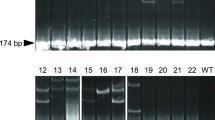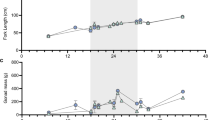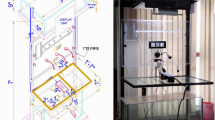Abstract
Interspecific transplantation of germ cells from the brown trout Salmo trutta m. fario and the European grayling Thymallus thymallus into rainbow trout Oncorhynchus mykiss recipients was carried out in order to improve current practices in conservation of genetic resources of endangered salmonid species in the Balkan Peninsula. Current conservation methods mainly include in situ efforts such as the maintenance of purebred individuals in isolated streams and restocking with purebred fingerlings; however, additional ex situ strategies such as surrogate production are needed. Steps required for transplantation such as isolation of high number of viable germ cells and fluorescent labeling of germ cells which are to be transplanted have been optimized. Isolated and labeled brown trout and grayling germ cells were intraperitoneally transplanted into 3 to 5 days post hatch rainbow trout larvae. Survival of the injected larvae was comparable to the controls. Sixty days after transplantation, fluorescently labeled donor cells were detected within the recipient gonads indicating successful incorporation of germ cells (brown trout spermatogonia and oogonia—27%; grayling spermatogonia—28%; grayling oogonia—23%). PCR amplification of donor mtDNA CR fragments within the recipient gonads additionally corroborated the success of incorporation. Overall, the transplantation method demonstrated in this study presents the first step and a possible onset of the application of the germ cell transplantation technology in conservation and revitalization of genetic resources of endangered and endemic species or populations of salmonid fish and thus give rise to new or improved management strategies for such species.



Similar content being viewed by others
References
Allendorf FW, Leary RF, Spruell P, Wenburg JK (2001) The problems with hybrids: setting conservation guidelines. Trends Ecol Evol 16:613–622. https://doi.org/10.1016/S0169-5347(01)02290-X
Asturiano JF, Cabrita E, Horváth Á (2017) Progress, challenges and perspectives on fish gamete cryopreservation: a mini-review. Gen Comp Endocrinol 245:69–76. https://doi.org/10.1016/j.ygcen.2016.06.019
Berrebi P, Povz M, Jesensek D, Cattaneo-Berrebi G, Crivelli AJ (2000) The genetic diversity of native, stocked and hybrid populations of marble trout in the Soca river, Slovenia. Heredity (Edinb) 85:277–287. https://doi.org/10.1046/j.1365-2540.2000.00753.x
Berrebi P, Tougard C, Dubois S, Shao Z, Koutseri I, Petkovski S, Crivelli A (2013) Genetic diversity and conservation of the Prespa trout in the Balkans. Int J Mol Sci 14:23454–23470. https://doi.org/10.3390/ijms141223454
Bianco PG (2014) An update on the status of native and exotic freshwater fishes of Italy. J Appl Ichthyol 30:62–77. https://doi.org/10.1111/jai.12291
Crête-Lafrenière A, Weir LK, Bernatchez L (2012) Framing the Salmonidae family phylogenetic portrait: a more complete picture from increased taxon sampling. PLoS One 7:e46662. https://doi.org/10.1371/journal.pone.0046662
Crivelli AJ, Poizat G, Berrebi P et al (2000) Conservation biology applied to fish: the example of a project for rehabilitating the marble trout (Salmo marmoratus) in Slovenia. Cybium 24:211–230
Dobrinski I, Avarbock MR, Brinster RL (1999) Transplantation of germ cells from rabbits and dogs into mouse testes. Biol Reprod 61:1331–1339. https://doi.org/10.1095/biolreprod61.5.1331
Falahatkar B, Poursaeid S, Kitada R, Yoshizaki G (2017) Hypothermic storage of isolated spermatogonia and oogonia from rainbow trout (Oncorhynchus mykiss). Cryobiology 76:125–128. https://doi.org/10.1016/j.cryobiol.2017.03.005
Fernández-Díez C, Pérez-Sanchiz R, Sarasquete C, Cabrita E, Herráez MP (2012) New tools for genome preservation: grafting germinal cells in brown trout (Salmo trutta). J Appl Ichthyol 28:916–918. https://doi.org/10.1111/jai.12077
Fumagalli L, Snoj A, Jesenšek D, Balloux F, Jug T, Duron O, Brossier F, Crivelli AJ, Berrebi P (2002) Extreme genetic differentiation among the remnant populations of marble trout (Salmo marmoratus) in Slovenia. Mol Ecol 11:2711–2716. https://doi.org/10.1046/j.1365-294X.2002.01648.x
Hewitt GM (1999) Post-glacial re-colonization of European biota. Biol J Linn Soc 68:87–112. https://doi.org/10.1111/j.1095-8312.1999.tb01160.x
Honaramooz A, Megee SO, Dobrinski I (2002) Germ cell transplantation in pigs. Biol Reprod 66:21–28. https://doi.org/10.1095/biolreprod66.1.21
Horváth Á, Jesenšek D, Csorbai B, Bokor Z, Raboczki É, Kaczkó D, Bernáth G, Hoitsy G, Urbányi B, Bajec SS, Snoj A (2012) Application of sperm cryopreservation to hatchery practice and species conservation: a case of the Adriatic grayling (Thymallus thymallus). Aquaculture 358–359:213–215. https://doi.org/10.1016/j.aquaculture.2012.07.012
Kise K, Yoshikawa H, Sato M, Tashiro M, Yazawa R, Nagasaka Y, Takeuchi Y, Yoshizaki G (2012) Flow-cytometric isolation and enrichment of teleost type A spermatogonia based on light-scattering properties. Biol Reprod 86:1–12. https://doi.org/10.1095/biolreprod.111.093161
Kottelat M, Freyhof J (2007) Handbook of European freshwater fishes. Imprimerie du Democrate, SA, Delemont
Lacerda SMSN, Batlouni SR, Silva SBG et al (2006) Germ cells transplantation in fish: the Nile-tilapia model. Anim Reprod 3:146–159
Lahnsteiner F, Weismann T, Patzner R (1996) Cryopreservation of semen of the grayling (Thymallus thymallus) and the Danube salmon (Hucho hucho). Aquaculture 144:265–274. https://doi.org/10.1016/S0044-8486(96)01308-7
Lahnsteiner F, Weismann T, Patzner RA (1997) Methanol as cryoprotectant and the suitability of 1.2 ml and 5 ml straws for cryopreservation of semen from salmonid fishes. Aquac Res 28:471–479. https://doi.org/10.1046/j.1365-2109.1997.00886.x
Lee S, Iwasaki Y, Shikina S, Yoshizaki G (2013) Generation of functional eggs and sperm from cryopreserved whole testes. Proc Natl Acad Sci U S A 110:1640–1645. https://doi.org/10.1073/pnas.1218468110
Linhartová Z, Rodina M, Guralp H, Gazo I, Saito T (2014) Isolation and cryopreservation of early stages of germ cells of tench (Tinca tinca). Czech J Anim Sci 59:381–390
Lujić J, Marinović Z, Sušnik Bajec S, Djurdjevič I, Kása E, Urbányi B, Horváth Á (2017) First successful vitrification of salmonid ovarian tissue. Cryobiology 76:154–157. https://doi.org/10.1016/j.cryobiol.2017.04.005
Marinović Z, Lujić J, Kása E, Bernáth G, Urbányi B, Horváth Á (2017) Cryosurvival of isolated testicular cells and testicular tissue of tench Tinca tinca and goldfish Carassius auratus following slow-rate freezing. Gen Comp Endocrinol 245:77–83. https://doi.org/10.1016/j.ygcen.2016.07.005
McCloy RA, Rogers S, Caldon CE et al (2014) Partial inhibition of Cdk1 in G2 phase overrides the SAC and decouples mitotic events. Cell Cycle 13:1400–1412
Okutsu T, Shikina S, Kanno M, Takeuchi Y, Yoshizaki G (2007) Production of trout offspring from triploid salmon parents. Science 317:1517. https://doi.org/10.1126/science.1145626
Okutsu T, Shikina S, Sakamoto T, Mochizuki M, Yoshizaki G (2015) Successful production of functional Y eggs derived from spermatogonia transplanted into female recipients and subsequent production of YY supermales in rainbow trout, Oncorhynchus mykiss. Aquaculture 446:298–302. https://doi.org/10.1016/j.aquaculture.2015.05.020
Pšenička M, Saito T, Linhartová Z, Gazo I (2015) Isolation and transplantation of sturgeon early-stage germ cells. Theriogenology 83:1085–1092. https://doi.org/10.1016/j.theriogenology.2014.12.010
Pustovrh G, Sušnik Bajec S, Snoj A (2011) Evolutionary relationship between marble trout of the northern and the southern Adriatic basin. Mol Phylogenet Evol 59:761–766. https://doi.org/10.1016/j.ympev.2011.03.024
Robles V, Riesco MF, Psenicka M, Saito T, Valcarce DG, Cabrita E, Herráez P (2017) Biology of teleost primordial germ cells (PGCs) and spermatogonia: biotechnological applications. Aquaculture 472:4–20. https://doi.org/10.1016/j.aquaculture.2016.03.004
Sato M, Morita T, Katayama N, Yoshizaki G (2014) Production of genetically diversified fish seeds using spermatogonial transplantation. Aquaculture 422–423:218–224. https://doi.org/10.1016/j.aquaculture.2013.12.016
Shedko SV, Miroshnichenko IL, Nemkova GA (2013) Phylogeny of salmonids (Salmoniformes: Salmonidae) and its molecular dating: analysis of mtDNA data. Russ J Genet 49:623–637. https://doi.org/10.1134/S1022795412050201
Shikina S, Nagasawa K, Hayashi M, Furuya M, Iwasaki Y, Yoshizaki G (2013) Short-term in vitro culturing improves transplantability of type a spermatogonia in rainbow trout (Oncorhynchus mykiss). Mol Reprod Dev 80:763–773. https://doi.org/10.1002/mrd.22208
Snoj A, Glamuzina B, Razpet A, Zablocki J, Bogut I, Lerceteau-Köhler E, Pojskić N, Sušnik S (2010) Resolving taxonomic uncertainties using molecular systematics: Salmo dentex and the Balkan trout community. Hydrobiologia 651:199–212. https://doi.org/10.1007/s10750-010-0297-5
Snoj A, Melkič E, Sušnik S et al (2002) DNA phylogeny supports revised classification of Salmothymus obtusirostris. Biol J Linn Soc 77:399–411
Sušnik S, Snoj A, Dovč P (2001) Evolutionary distinctness of grayling (Thymallus thymallus) inhabiting the Adriatic river system, as based on mtDNA variation. Biol J Linn Soc 74:375–385. https://doi.org/10.1006/bijl.2001.0583
Sušnik S, Snoj A, Wilson IF et al (2007) Historical demography of brown trout (Salmo trutta) in the Adriatic drainage including the putative S. letnica endemic to Lake Ohrid. Mol Phylogenet Evol 44:63–76. https://doi.org/10.1016/j.ympev.2006.08.021
Sušnik Bajec S, Pustovrh G, Jesenšek D, Snoj A (2015) Population genetic SNP analysis of marble and brown trout in a hybridization zone of the Adriatic watershed in Slovenia. Biol Conserv 184:239–250. https://doi.org/10.1016/j.biocon.2015.01.033
Vincenzi S, Crivelli AJ, Jesenšek D, De Leo GA (2010) The management of small, isolated salmonid populations: do we have to fix it if it ain’t broken? Anim Conserv 13:21–23. https://doi.org/10.1111/j.1469-1795.2009.00292.x
Vincenzi S, Mangel M, Jesenšek D et al (2016) Within and among-population variation in vital rates and population dynamics in a variable environment. Ecol Appl 26:2086–2102. https://doi.org/10.1101/028662
Ye J, Coulouris G, Zaretskaya I, Cutcutache I, Rozen S, Madden TL (2012) Primer-BLAST: a tool to design target-specific primers for polymerase chain reaction. BMC Bioinformatics 13:134
Yoshizaki G, Fujinuma K, Iwasaki Y, Okutsu T, Shikina S, Yazawa R, Takeuchi Y (2011) Spermatogonial transplantation in fish: a novel method for the preservation of genetic resources. Comp Biochem Physiol Part D Genomics Proteomics 6:55–61. https://doi.org/10.1016/j.cbd.2010.05.003
Yoshizaki G, Ichikawa M, Hayashi M, Iwasaki Y, Miwa M, Shikina S, Okutsu T (2010) Sexual plasticity of ovarian germ cells in rainbow trout. Development 137:1227–1230. https://doi.org/10.1242/dev.044982
Acknowledgements
We would like to thank Dr. Goro Yoshizaki and his team for the valuable training and support during this research. We would also like to express our gratitude to the manager of the Bled hatchery (Slovenia) for providing juvenile fish for all the experiments and the manager of the Vodomec hatchery (Slovenia) for rearing the rainbow trout fry.
Funding
This study was supported by the National Research, Development and Innovation Office of Hungary (grants SNN 116912 to ÁH and FK 124585 to JL), the Slovenian Research Agency (grants N4-0045 and P4-0220), and the Stipendium Hungaricum Scholarship Programme (grant 106360 to ZM).
Author information
Authors and Affiliations
Corresponding author
Ethics declarations
Treatment of the animals was carried out following the Slovenian national regulations, and the experimental procedures were approved by the Administration of the Republic of Slovenia for Food Safety, Veterinary Sector and Plant Protection, Ministry of Agriculture and Environment (decision letter U34401-30/2013/4).
Rights and permissions
About this article
Cite this article
Lujić, J., Marinović, Z., Bajec, S.S. et al. Interspecific germ cell transplantation: a new light in the conservation of valuable Balkan trout genetic resources?. Fish Physiol Biochem 44, 1487–1498 (2018). https://doi.org/10.1007/s10695-018-0510-4
Received:
Accepted:
Published:
Issue Date:
DOI: https://doi.org/10.1007/s10695-018-0510-4




